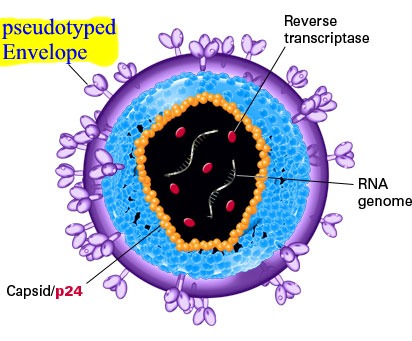
What is Virus-Like Particles (VLP)?
A viral envelope is the outermost layer of the virus, consist of the glycoproteins. It serves to bind the receptor on the host’s cell membrane. When desired, the virus can be enveloped with a desired protein (so called pseudo-typing). The glycoproteins that able to maintain a viral particle structure, can be used as that virus’s envelope proteins.
Gentarget’s VLP of COVID-19 Spike (S) protein
Gentarget developed the virus-like particle product line as different pseudo-typed lentiviral particles. They are pseudo-typed with a desired envelope protein at its surface. It is packaged with a report (GFP or Luciferase) as virion core.
Such VLP are non-replicative, non-pathogenic and non-infectious to mammalian cells, or only infect the specific cell types that containing the corresponding receptor to the pseudo-typed envelope protein. If the mammalian cells can be successfully infected with VLP, it will express its GFP or Luciferase. However, more often, the lentiviral-like-particles are used for many applications related to the envelope protein.
Currently, Gentarget provides the VLP pseudo-typed with the Spike protein (S) of COVID-19 or SARS-CoV-2 coronavirus, packaged with either with eGFP (CAT#: VLP001) or firefly luciferase (CAT#: VLP002).
Why use VLP?
- Immunization and Antibody Screening by ELISA: The COVID 19 (S) VLP effectively present the Spike protein as surface target, or Mimic COVID-19 Structure which is easier access to human immune response and more effectively activate the immune response. Therefore, the most effective antibodies can be raised from the VLP. So VLP can are often used as the more representative antigens or immunogen for antibody development and validation, or R&D immunoassays, vaccine research. In some cases, those VLP replace the active, dangerous live COVID-19 virus in your assays.
- Targeted delivery: The COVID-19 VLPs are a target delivery of the report (here, GFP or Luciferase) to any cells containing the receptors that can bind to SARS-CoV-2 Spike Protein (S).